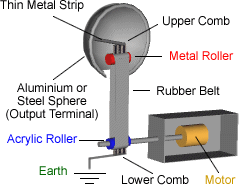Van de Graaff Generator
Van de Graaff Robert J. Van de Graaff was an American physicist who, in 1929, invented a device called the Van de Graff generator. You may have seen, or even used, a Van de Graaff generator in the classroom at school. It is an electrostatic generator which uses an acrylic roller and rubber belt to amass very high voltages which are accumulate in a hollow metal sphere. How a Van de Graaff generator works

You may also be interested in:
how static electricity works
how lightning works
Tags: what is static electricity; how does static electricity work; uses of static electricity; what is static electricity; earthing; charging by induction; friction; how does a Van de Graaff Generator work, How does the Van de Graaff Generator work